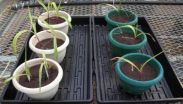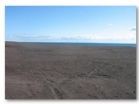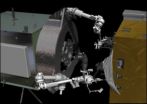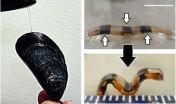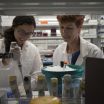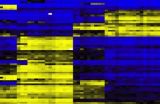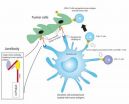(Press-News.org) Scientists have known for years that together, bacteria and plants can remediate contaminated sites. Ramakrishna Wusirika, of Michigan Technological University, has determined that how you add bacteria to the mix can make a big difference.
He has also shed light on the biochemical pathways that allow plants and bacteria to clean up some of the worst soils on the planet while increasing their fertility.
Wusirika, an associate professor of biological sciences, first collected stamp sands near the village of Gay, in Michigan's Upper Peninsula. For decades, copper mining companies crushed copper ore and dumped the remnants—an estimated 500 million tons of stamp sand—throughout the region. Almost nothing grows on these manmade deserts, which are laced with high concentrations of copper, arsenic and other plant-unfriendly chemicals.
Then, Wusirika and his team planted maize in the stamp sand, incorporating bacteria in four different ways:
mixing it in the stamp sand before planting seed;
coating seed with bacteria and planting it;
germinating seeds and planting them in soil to which bacteria were added; and
the conventional method, immersing the roots of maize seedlings in bacteria and planting them in stamp sand.
After 45 days, the team uprooted the plants and measured their dry weight. All maize grown with bacteria was significantly more vigorous—from two to five times larger—than the maize grown in stamp sand alone. The biggest were those planted as seedlings or as germinated seeds.
However, when the researchers analyzed the dried maize, they made a surprising discovery: the seed-planted maize took up far more copper as a percentage of dry weight. In other words, the smaller plants pulled more copper, ounce per ounce, out of the stamp sands than the bigger ones.
That has implications for land managers trying to remediate contaminated sites, or even for farmers working with marginal soils, Wusirika said. The usual technique—applying bacteria to seedlings' roots before transplanting—works fine in the lab but would be impractical for large-scale projects. This could open the door to simple, practical remediation of copper-contaminated soils.
But the mere fact that all the plants grown with bacteria did so well also piqued his curiosity. "When we saw this, we wondered what the bacteria were doing to the soil," Wusirika said. "Based on our research, it looks like they are improving enzyme activity and increasing soil fertility," in part by freeing up phosphorus that had been locked in the rock.
The bacteria are also changing copper into a form that the plants can take up. "With bacteria, the exchangeable copper is increased three times," he said. "There's still a lot of copper that's not available, but it is moving in the right direction."
By analyzing metabolic compounds, the team was able to show that the bacteria enhance photosynthesis and help the plants make growth hormones. Bacteria also appear to affect the amount phenolics produced by the maize. Phenolics are antioxidants similar to those in grapes and red wine.
Compared to plants grown in normal soil without bacteria, plants grown in stamp sand alone showed a five-fold increase in phenolics. However, phenolics in plants grown in stamp sand with bacteria showed a lesser increase.
"Growing in stamp sand is very stressful for plants, and they respond by increasing their antioxidant production," Wusirika said. "Adding the metal-resistant bacteria enables the plants to cope with stress better, resulting in reduced levels of phenolics."
"There's still a lot to understand here," he added. "We'd like to do a study on stamp sands in the field, and we'd also like to work with plants besides maize. We think this work has applications in organic agriculture as well as remediation."
INFORMATION:
Wusirika's work is featured on the research crowdfunding site Superior Ideas. To find out more, visit http://www.superiorideas.org/projects/phytoremediation-natural-bacteria.
An article on their work, "Integrated Metabolomic and Proteomic Approaches Dissect the Effect of Metal-Resistant Bacteria on Maize Biomass and Copper Uptake," coauthored by PhD graduate student Kefeng Li, now at the University of California at San Diego; graduate students Venkataramana R. Pidatala and Rafi Shaik; Associate Professor Rupali Datta; and Wusirika has been published in the January issue of Environmental Science and Technology.
Maize and bacteria: A 1-2 punch knocks copper out of stamp sand
Tweaking techniques could open the door to large-scale remediation of toxic mine sites
2014-03-05
ELSE PRESS RELEASES FROM THIS DATE:
NASA tests new robotic refueling technologies
2014-03-05
NASA has successfully concluded a remotely controlled test of new technologies that would empower future space robots to transfer hazardous oxidizer – a type of propellant – into the tanks of satellites in space today.
Concurrently on the ground, NASA is incorporating results from this test and the Robotic Refueling Mission on the International Space Station to prepare for an upcoming ground-based test of a full-sized robotic servicer system that will perform tasks on a mock satellite client.
Collectively, these efforts are part of an ongoing and aggressive technology ...
OU study suggests non-uniform climate warming global
2014-03-05
A recent University of Oklahoma study of five decades of satellite data, model simulations and in situ observations suggests the impact of seasonal diurnal or daily warming varies between global regions affecting many ecosystem functions and services, such as food production, carbon sequestration and climate regulation. The effects of non-uniform climate warming on terrestrial ecosystems is a key challenge in carbon cycle research and for those making future predictions.
Jianyang Xia, a research associate in the OU College of Arts and Sciences, says the impact of non-uniform ...
A small step toward discovering habitable earths
2014-03-05
University of Arizona researchers snapped images of a planet outside our solar system with an Earth-based telescope using essentially the same type of imaging sensor found in digital cameras instead of an infrared detector. Although the technology still has a very long way to go, the accomplishment takes astronomers a small step closer to what will be needed to image earth-like planets around other stars
"This is an important next step in the search for exoplanets because imaging in visible light instead of infrared is what we likely have to do if we want to detect planets ...
Researchers find potential target for drug to treat allergic asthma
2014-03-05
COLUMBUS, Ohio – An enzyme that helps maintain immune system function by "throwing away" a specific protein has a vital role in controlling symptoms of allergic asthma, new research in mice suggests.
The finding suggests that this enzyme, called Cbl-b, could be a target for drugs used to treat allergic asthma and other autoimmune disorders.
This new study, led by Ohio State University researchers, is the first to link Cbl-b to allergic asthma in an animal model.
The findings parallel results from a 2012 Yale study in humans, which suggested that a mutation in the ...
Pumping iron: A hydrogel actuator with mussel tone
2014-03-05
Protein from a small, tasty mollusk inspired Michigan Technological University's Bruce P. Lee to invent a new type of hydrogel actuator.
Hydrogels are soft networks of polymers with high water content, like jello. Because of their soft, gentle texture, they have the potential to interact safely with living tissues and have applications in a number of medical areas, including tissue engineering. Lee, an assistant professor of biomedical engineering, wanted to make a hydrogel that wouldn't just sit there.
"Hydrogels that can change shape on command could be used to deliver ...
Going viral to target tumors
2014-03-05
March 5, 2014, New York, NY– A Ludwig Cancer Research study suggests that the clinical efficacy of checkpoint blockade, a powerful new strategy to harness the immune response to treat cancers, might be dramatically improved if combined with oncolytic virotherapy, an investigational intervention that employs viruses to destroy tumors.
Published today in the journal Science Translational Medicine, the study evaluated a combination therapy in which the Newcastle disease virus (NDV), a bird virus not ordinarily harmful to humans, is injected directly into one of two melanoma ...
Biomarkers of cell death in Alzheimer's reverse course after symptom onset
2014-03-05
Three promising biomarkers being studied to detect Alzheimer's disease in its early stages appear to undergo a surprising shift as patients develop symptoms of dementia, researchers at Washington University School of Medicine in St. Louis report.
Scientists use the biomarkers to assess brain changes linked to the disease in research volunteers. The levels of markers of neuronal injury increase in the spinal fluid for a decade or more before the onset of dementia, but in a new twist, the research shows for the first time that they later reverse course, decreasing as symptoms ...
An inventive new way to profile immune cells in blood
2014-03-05
ROVIDENCE, R.I. [Brown University] — When a person becomes sick or is exposed to an unwelcome substance, the body mobilizes specific proportions of different immune cells in the blood. Methods of discovering and detecting those profiles are therefore useful both clinically and in research. In a new paper in the journal Genome Biology, a team of scientists describes a new and uniquely advantageous way to detect them.
All the current means of counting immune cells in a blood sample require whole cells, said Karl Kelsey, professor of epidemiology at Brown and corresponding ...
Novel cancer vaccine holds promise against ovarian cancer, mesothelioma
2014-03-05
A novel approach to cancer immunotherapy – strategies designed to induce the immune system to attack cancer cells – may provide a new and cost-effective weapon against some of the most deadly tumors, including ovarian cancer and mesothelioma. Investigators from the Massachusetts General Hospital (MGH) Vaccine and Immunotherapy Center report in the Journal of Hematology & Oncology that a protein engineered to combine a molecule targeting a tumor-cell-surface antigen with another protein that stimulates several immune functions prolonged survival in animal models of both ...
Hungry for 'likes': Frequent Facebook use linked to eating disorder risk, study finds
2014-03-05
TALLAHASSEE, Fla. — Frequent Facebook users might be sharing more than party pictures, vacation videos and shameless selfies — they also share a greater risk of eating disorders, according to a new study led by Florida State University researchers.
Psychology Professor Pamela K. Keel studied 960 college women and found that more time on Facebook was associated with higher levels of disordered eating. Women who placed greater importance on receiving comments and "likes" on their status updates and were more likely to untag photos of themselves and compare their own photos ...
LAST 30 PRESS RELEASES:
Penn researchers awarded $25M to conduct trial using smartphones to fight heart disease
PCORI awards funding for new patient-centered healthcare research
Exploring the origins of the universe: 145 low-noise amplifiers complete ALMA telescopes
Empress cicada wings help illuminate molecular structure
Using sound waves to detect helium
Time burden in patients with metastatic breast and ovarian cancer from clinic and home demands
Researchers discover bias in AI models that analyze pathology samples
Scientists ID potential way to prevent brain injuries from triggering Alzheimer's
MASTER 2nd Open Call: Execution period kick-off
Algae for health in food and pharma
Advanced microrobots driven by acoustic and magnetic fields for biomedical applications
Chicago health information leader recognized for raising CPR readiness and blood pressure awareness
The Intimate Animal, a new book from Kinsey Institute Executive Director Dr. Justin Garcia
When blue-collar workers lose union protection, they try self-employment
New video dataset to advance AI for health care
MEA-based graph deviation network for early autism syndrome signatures in human forebrain organoids
New modeling approach sheds light on rare gut disease
Study documents potentially hazardous flame retardants in firefighter gear
Can certain bacteria regulate aging of the immune system and its related alterations?
AI model helps diagnose often undetected heart disease from simple EKG
There are fewer online trolls than people think
Cell membrane fluctuations produce electricity
Jeonbuk National University study shows positive parenting can protect adolescents against self-harm
Surface-engineered ZnO nanocrystals to tackle perfluoroalkyl substance contamination
This new understanding of T cell receptors may improve cancer immunotherapies
A new fossil face sheds light on early migrations of ancient human ancestor
A new immunotherapy approach could work for many types of cancer
A new way to diagnose deadly lung infections and save lives
40 percent of MRI signals do not correspond to actual brain activity
How brain-inspired algorithms could drive down AI energy costs
[Press-News.org] Maize and bacteria: A 1-2 punch knocks copper out of stamp sandTweaking techniques could open the door to large-scale remediation of toxic mine sites
